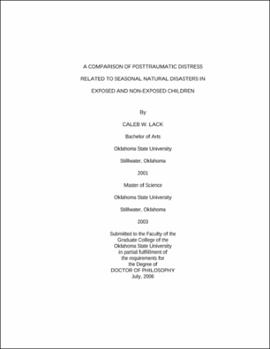| dc.contributor.advisor | Sullivan, Maureen A. | |
| dc.contributor.author | Lack, Caleb W. | |
| dc.date.accessioned | 2013-11-26T08:27:42Z | |
| dc.date.available | 2013-11-26T08:27:42Z | |
| dc.date.issued | 2006-07 | |
| dc.identifier.uri | https://hdl.handle.net/11244/6957 | |
| dc.description.abstract | Scope and Method of Study: This study was designed to assess and follow the presence of posttraumatic stress disorder symptomology in children exposed to a tornado and compare that to the same symptomology in demographically similar children who had not been exposed to a tornado. This was done to examine the differences between these groups, both of whom live in a disaster-prevalent area, inside and outside of tornado season. The study also examined the roles that re-exposure to environmental cues, exposure to disaster-related media, attributions, and other factors play in maintaining a child's level of distress, as well as the children's general behavioral and emotional functioning. Participants in the study were 95 exposed children and 70 non-exposed children ages 8-12. The exposed children had at least one tornado strike their hometown in late May or early June 2004, while the non-exposed children's hometown had not had a tornado within 10 miles of it in the past five years. Each participant and their parent completed a series of questionnaires designed to measure the above variables in November 2004 (6 months post tornado and outside tornado season) and May 2005 (12 months post tornado and inside tornado season). | |
| dc.description.abstract | Findings and Conclusions: The current study supported the proposed stability of posttraumatic distress symptoms in tornado-exposed children, showing no decrease from six to 12 months post tornado. Also supported was the difference in posttraumatic distress symptom level between exposed and non-exposed children, with non-exposed children displaying significantly lower amounts of tornado-related PTSD symptoms both outside and inside tornado season than exposed children. The degree of difference between these two groups, while statistically significant, was not as large as expected, as the non-exposed children did show mild levels of posttraumatic distress. In contrast to expectations, results showed that tornado-specific distress was not related to more global behavioral or emotional functioning. The current study also supported the relationship between the factors of exposure, attributions, and distress. | |
| dc.format | application/pdf | |
| dc.language | en_US | |
| dc.rights | Copyright is held by the author who has granted the Oklahoma State University Library the non-exclusive right to share this material in its institutional repository. Contact Digital Library Services at lib-dls@okstate.edu or 405-744-9161 for the permission policy on the use, reproduction or distribution of this material. | |
| dc.title | Comparison of posttraumatic distress related to seasonal natural disasters in exposed and non-exposed children | |
| dc.contributor.committeeMember | Chaney, John M. | |
| dc.contributor.committeeMember | Potts, Richard | |
| dc.contributor.committeeMember | Hubbs-Tait, Laura | |
| osu.filename | Lack_okstate_0664D_1895.pdf | |
| osu.accesstype | Open Access | |
| dc.type.genre | Dissertation | |
| dc.type.material | Text | |
| thesis.degree.discipline | Psychology | |
| thesis.degree.grantor | Oklahoma State University | |
